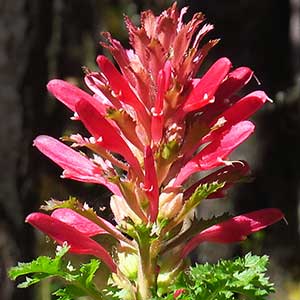Pedicularis densiflora
Pedicularis crenulata
Indian warrior, warrior's plume
meadow lousewort, scalloped-leaf lousewort
basal 1–10, blade lanceolate, 30–200 x 20–70 mm, 2(or 3)-pinnatifid, margins of adjacent lobes nonoverlapping or extensively overlapping distally, 1-serrate, surfaces glabrous, hispid, or downy;
cauline 4–20, blade lanceolate, 15–250 x 5–100 mm, 2-pinnatifid, margins of adjacent lobes nonoverlapping or extensively overlapping distally, serrate, surfaces glabrous, hispid, or downy.
basal 8–10, blade narrowly elliptic to linear, 15–40 x 3–6 mm, undivided, margins of adjacent lobes nonoverlapping, 2-crenate, surfaces glabrous;
cauline 10–40, blade linear to narrowly oblanceolate, 10–60 x 2–6 mm, undivided, margins of adjacent lobes nonoverlapping, 2-crenate, surfaces glabrous.
simple, 1–5, exceeding basal leaves, each 10–50-flowered;
bracts lanceolate to trullate, 10–35 x 3–5 mm, undivided or 1-pinnatifid, proximal margins entire, distal 1- or 2-serrate, surfaces glabrous.
simple, 1–10, exceeding basal leaves, each 10–50-flowered;
bracts triangular or lanceolate to oblanceolate, 10–15 x 3–4 mm, undivided, proximal margins entire, distal crenate to 2-crenate, surfaces glabrous.
2–4 mm.
3–3.5 mm.
calyx 9–18 mm, downy to tomentose, lobes 5, triangular, 3–4 mm, apex entire, ciliate;
corolla 23–43 mm, tube dark red, purple, or orange-yellow, rarely white, 8–18 mm;
galea dark red, purple, or orange-yellow, rarely white, 15–25 mm, beakless, margins entire medially and distally, apex straight;
abaxial lip dark red, purple, or orange-yellow, rarely white, 8–15 mm.
calyx 8.5–11 mm, hirsute along veins or glabrous, lobes 2, triangular, 0.5–1 mm, apex entire, glabrous or ciliate;
corolla 20–26 mm, tube light pink, rarely white, 12–15 mm;
galea reddish violet, sometimes white, 8–11 mm, beakless, margins entire medially, 1-toothed distally, apex arching over abaxial lip;
abaxial lip reddish violet, sometimes white, 4–8 mm.
= 16.
Pedicularis densiflora
Pedicularis crenulata
Scarlet corollas with an undomed, toothless galea and two- or three-pinnatifid leaves are diagnostic of Pedicularis densiflora. This species occurs in forested subalpine regions of southern Oregon, western slopes of the Sierra Nevada, and the Coast Ranges of California south to Baja California. Herbarium records indicate northern populations of P. densiflora occur at higher elevations than do more southern populations.
(Discussion copyrighted by Flora of North America; reprinted with permission.)
Pedicularis crenulata is abundant in moist swales of alpine to subalpine sagebrush meadows of the mid to southern Rocky Mountains, as well as California and Nevada, where large populations with their reddish violet flowers create a distinctive swath across the otherwise green landscape. The undivided, nearly linear leaves with two-crenate margins are unique among North American species of Pedicularis. The galea bears a single apical tooth on each abaxial margin at the distal tip. Other species with the combination of two calyx lobes and undivided, linear to nearly linear leaves are P. angustifolia and P. racemosa.
(Discussion copyrighted by Flora of North America; reprinted with permission.)


